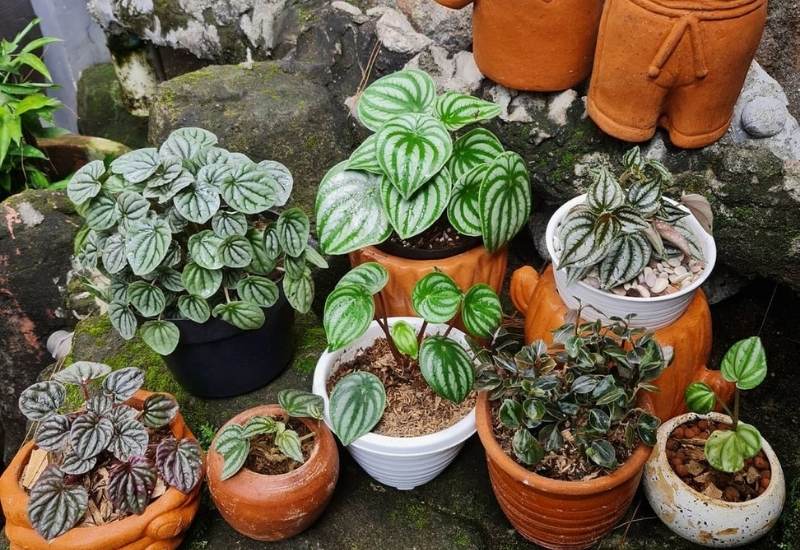
Peperomia plants are an extremely common tropical houseplant known for their thick stems, fleshy leaves, and lovely ornamental foliage.
The great diversity of shapes, colors and structures of its leaves makes Peperomia a versatile indoor plant, each variety of which has its own appearance and in addition, it purifies the air.
Peperomia comes in many shapes and sizes and in various colors that range from green to pink. These plants have great decorative value due to their shape and the colorful pattern of their leaves. They can be small and lush but their growth form can vary widely from species to species.
Some smaller peperomia varieties can have thick leaves that resemble a succulent, while others can have striped leaves, heart-shaped leaves, or even long trailing stems with tiny leaves.
In general, peperomia plants should be grown in well-draining potting soil with moderate to bright, indirect sunlight.
Water as often as the soil surface dries and mist leaves regularly to provide increased humidity. These plants thrive in warm locations, so positioning on or near a radiator is also beneficial.
Native to Mexico, South America, and the Caribbean, Peperomia is a large genus of tropical plants in the family Piperaceae. There are approximately 1,600 varieties of peperomia available for both indoor and outdoor gardens, and they’re all relatively easy to care for.
With so many different varieties to choose from, it can be hard to decide which species is right for you! Read on to learn about the best types of peperomia for your houseplant collection and how to keep them thriving in your space.
Related: How To Care For Peperomia Plants
Peperomia Plant Overview?
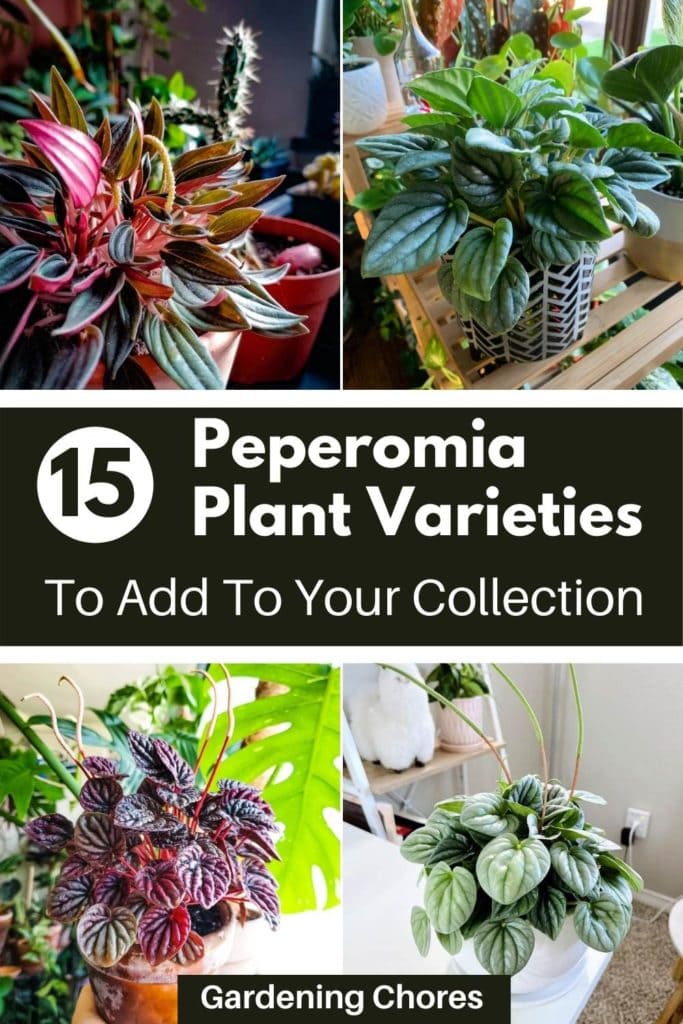
The name Peperomia (also known as radiator plant) refers to a genus of tropical plants which contains over 1500 species.
Native to Central and South America, these plants are mostly perennial epiphytes, meaning their roots are able to absorb nutrients and moisture from air and water. As a result, these plants are most often found growing below the canopy using a host, like rotting wood.
Due to their compact size and low nutrient requirements, they make excellent low maintenance houseplants.
Many types of peperomia plants do closely resemble succulents and have succulent-like leaves, which are able to store extra water. This why it is important to avoid overwatering, as they can be quite susceptible to root rot.
Peperomia plants generally require higher humidity conditions, as with most epiphytes. The common name of ‘radiator plants’ is derived from their preference to warm conditions with bright light.
While peperomia plants can have vastly different variations in growth forms and foliage, there is one common similarity.
Most peperomia plants produce insignificant flowers which look like white or greenish spikes at the end of a long stem. However, it is unlikely that a peperomia plant will flower indoors.
15 Peperomia plant Varieties To Add To Your Houseplant Collection
So, let’s explore some of the most common types of peperomia plants for growing indoors.
1. Peperomia obtusifolia (Baby Rubber Plant)
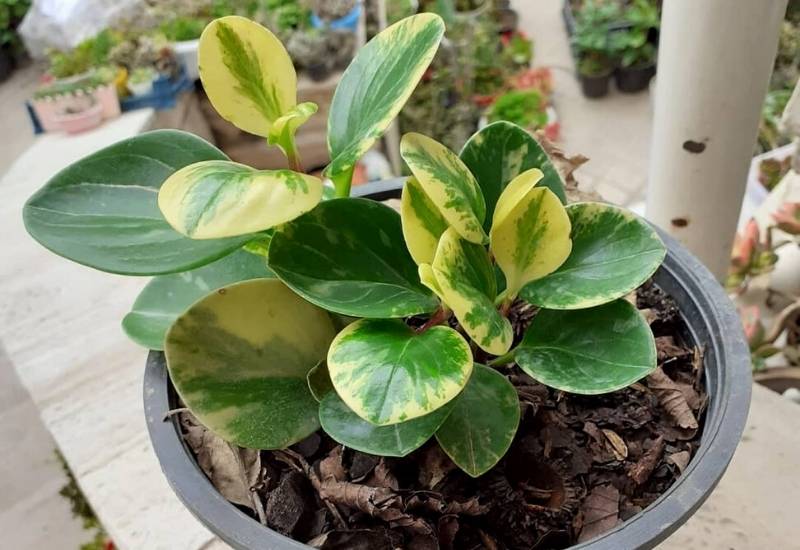
The baby rubber plant is a small, bushy succulent-like variety of Peperomia with tall upright stems.
Their glossy evergreen leaves are slightly concave, creating a somewhat cupped shape. These plants usually grow to about 25-30cm tall, and require bright light to maintain their lush green color.
They can also come in a wide variety of interesting and unique cultivars, including some with creamy-white leaves, dark green and ivory, or even golden yellow variegation.
Also known as the pepper face peperomia, peperomia obtusifolia do produce the beautiful, yet insignificant flowers. While uncommon indoors, it can happen if the ideal conditions are pro-vided.
2. Peperomia argyreia (Watermelon Peperomia)
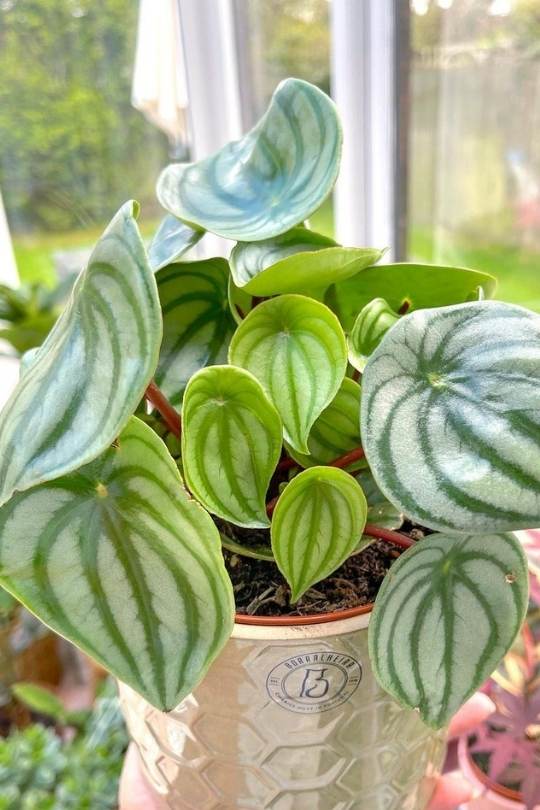
Watermelon peperomia plants have large, heart-shaped, green leaves with silver stripes which closely resemble the skin of a watermelon.
The leaves are attached to beautiful red stems which grow as a bushy rosette, making this plant ideal as a ground cover or grouped with other plants indoors.
These plants are easy to care for, making them a good choice for beginner plant owners. While preferring higher humidity conditions with bright light, they can also be drought tolerant and survive in lower light as well.
Watermelon peperomia plants can produce insignificant flowers which look like greenish spikes, however their unmistakable charm is all about the foliage.
3. Peperomia rotundifolia (Trailing Jade Peperomia)
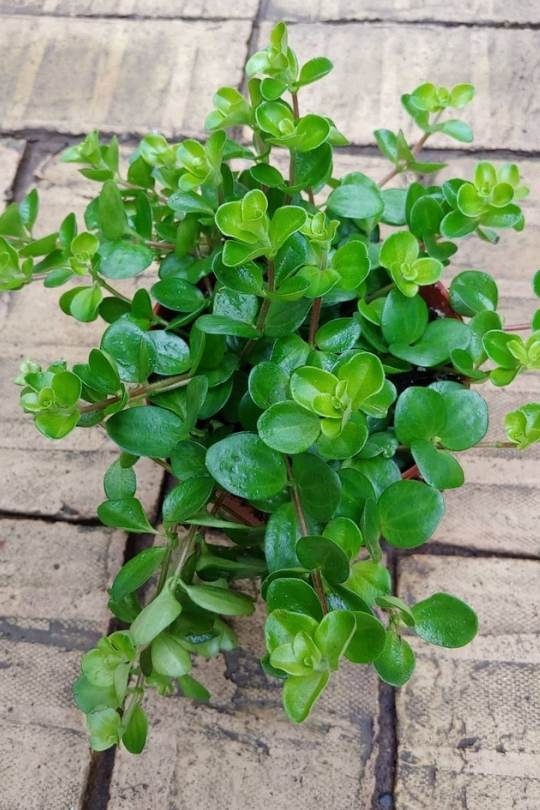
Trailing jade peperomias have small, round, fleshy leaves similar to that of a succulent. These leaves are attached to lengthy trailing stems which will intertwine as they grow, giving a bushy appearance.
Native to South American rain forests, Peperomia rotundifolia is a perennial epiphyte plant species would normally be found crawling in the undergrowth and clinging to rocks and dead wood.
As with in their natural habitat, trailing jade peperomias thrive on moisture, warm temperatures, and shady conditions.
If grown a hanging basket, mist the leaves regularly to increase humidity. Be sure to keep the temperature consistent, ideally between 64°F and 75°F (18°C – 24°F).
4. Peperomia clusiifolia (Peperomia Jelly)
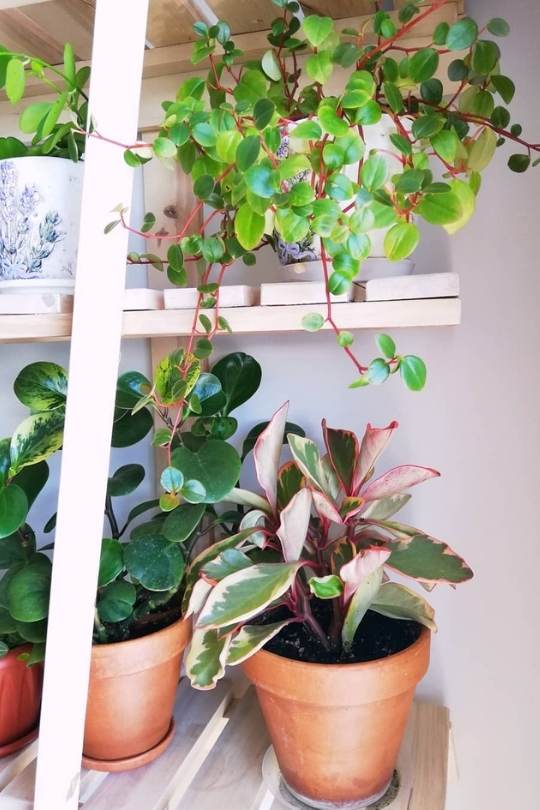
The peperomia jelly is a gorgeous houseplant with uniquely multicolored leaves. The leaves will usually appear green in the center, followed by a cream-colored strip which fades to pink and then red around the edges.
Other common names include red edge peperomia, Ginny peperomia, and tricolor peperomia. This plants easy-to-grow manner, compact form, and colorful pointed oval leaves make it an ideal houseplant.
They can even thrive under artificial florescent lighting. While the peperomia jelly will tolerate low light conditions, bright indirect light is required for this plant to reach its full potential, due to the variegation.
If kept in lower light conditions the plant will survive, but the leaves will be mostly green.
5. Peperomia Scandens (Cupid Peperomia)
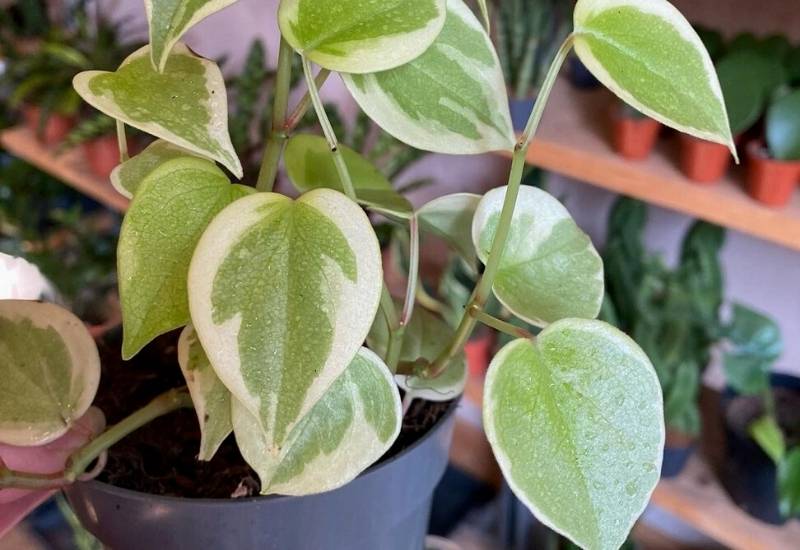
There are two types of peperomia scandens, one with green leaves and the other with variegated leaves. Both versions of this peperomia are trailing plants with thick, glossy, heat-shaped leaves.
Cupid peperomia vines are very easy to care for. Originating from the tropical rainforests of Mexico and South America, these plants thrive in humid conditions with bright, indirect light. They will even do very well in artificial light with occasional watering and misting.
6. Peperomia orba (Teardrop Peperomia)
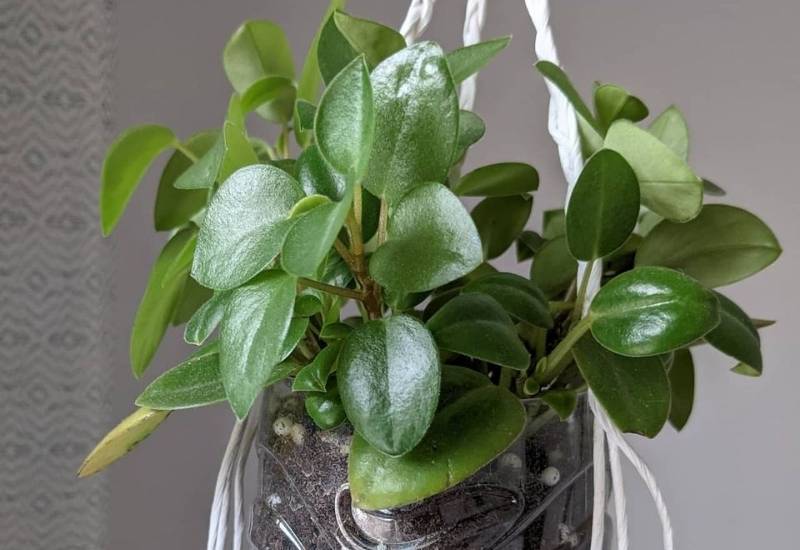
Teardrop peperomias feature small, oval-shaped leaves with varying types of foliage depending on the cultivar.
They will generally grow twice as wide as they do tall, appearing as a small bushy plant. They can either be a solid green color, light green to almost yellow, or variegated green with golden-yellow edges.
Once the plant is mature, a white line will appear down the center of its waxy leaves. This plant is extremely easy to care for, making it ideal for terrariums, or first time plant owners.
Tolerant to neglect, it can survive in most rooms with little maintenance. Provide moderate light and water only once the soil has dried.
7. Peperomia caperata ‘Emerald’ (Emerald Ripple Peperomia)
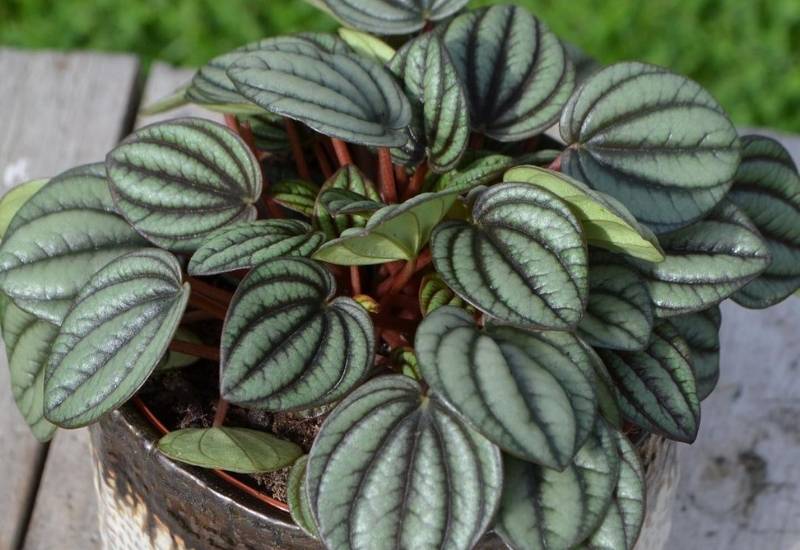
The emerald ripple peperomia is an unmistakably beautiful cultivar of the peperomia caperata species. Ripple peperomia plants display eye-catching shiny, oval leaves with a distinct corrugated ap-pearance.
While the emerald ripple cultivar features a lush dark red or almost purple color, other cultivars can range from green to silver-grey with red blushing.
These plants tend to remain quite compact in their growth form, making them perfect for a shelf or table top. As with most peperomias, they prefer bright indirect light with moderate watering and occasional misting.
8. Peperomia caperata ‘Rosso’ (Peperomia Rosso)
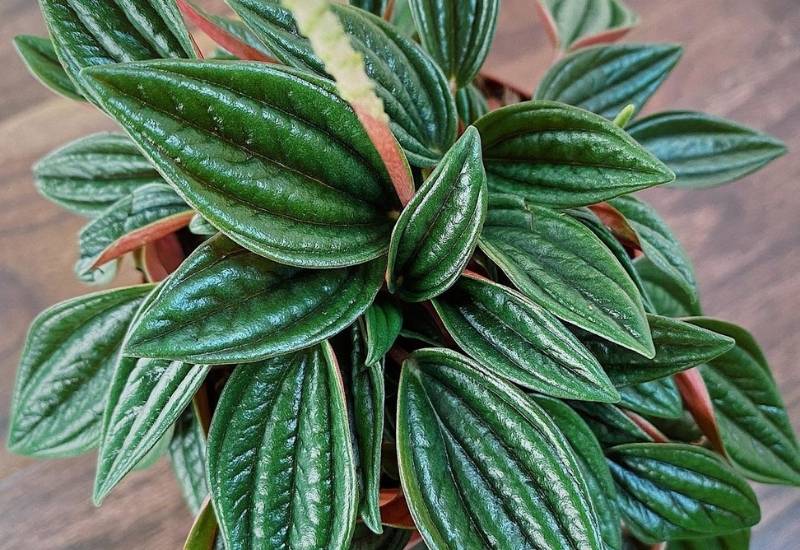
Another equally beautiful cultivar of the peperomia caperata species, is the peperomia rosso. This plant is an attractive flowering peperomia variety with dark green leaves and deep reddish-brown undersides.
Their glossy, skinny, pointed leaves are deeply grooved, giving them the rippled appearance. Also growing as a compact bushy plant, their dark leaf color makes them ideal for rooms with minimal access to sunlight.
However as with other flowering peperomias, they will need at least 11 hours of light to bloom. With sufficient light, they can produce the customary peperomia white flower spikes.
9. Peperomia prostrata (String of Turtles)
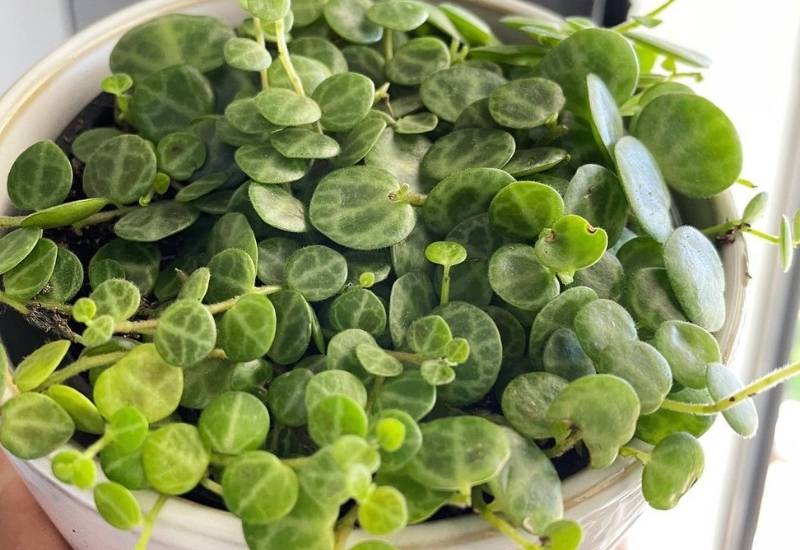
String of turtles peperomia plants are a very dainty and delicate species of peperomia. They fea-ture long, cascading strings of tiny circular leaves which can fall off quite easily.
As described by its common name, the leaves appear to have light green veins which resemble a turtles shell. While a hanging basket is ideal for a string of turtles, these trailing peperomia plants can also spread outwards on a desk or table.
However, it is important not to disturb this plant too much, so a location where it will not easily be bumped is crucial.
In addition to their sensitivity to movement, they are also vulnerable to temperature fluctuations. Both of these disturbances can lead to leaf drop.
It is also very difficult to repot a string of turtles plant, due to their delicate stems. Fortunately, their extremely slow growth habit means they can remain happily the same pot for years.
10. Peperomia tetraphylla ‘Hope’ (Peperomia Hope)
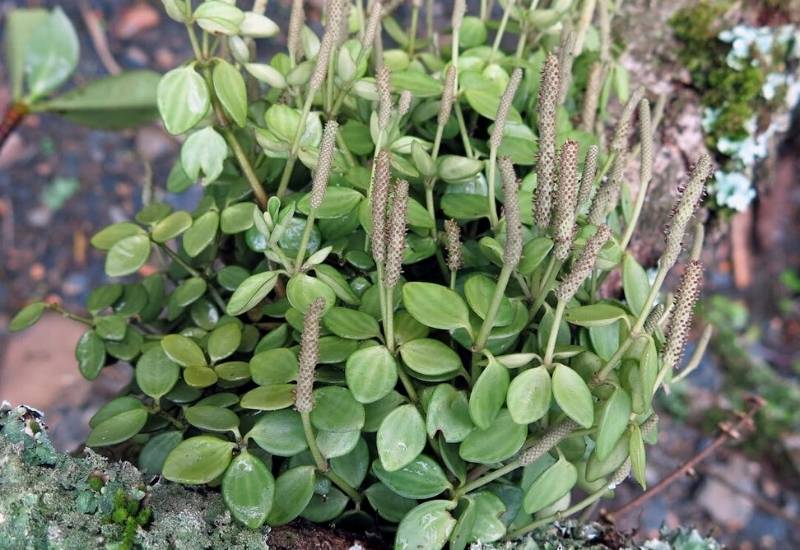
Also known as the acorn peperomia or four-leaved peperomia, peperomia ‘hope’ is best suited for hanging baskets. With a similar appearance to the tailing jade peperomia, they have long, trailing stems and thick oval leaves.
One major difference is that the leaves of the peperomia ‘hope’ plant tend to grow bunched in groups of 3 or 4.
The botanical name tetraphylla is actually Latin for “four leaves.” This growth habit comes from the fact that the peperomia ‘hope’ happens to be a hybrid of two other types of peperomia plants – the Peperomia deppeana and Peperomia quadrifolia.
11. Peperomia graveolens (Ruby Glow Peperomia)
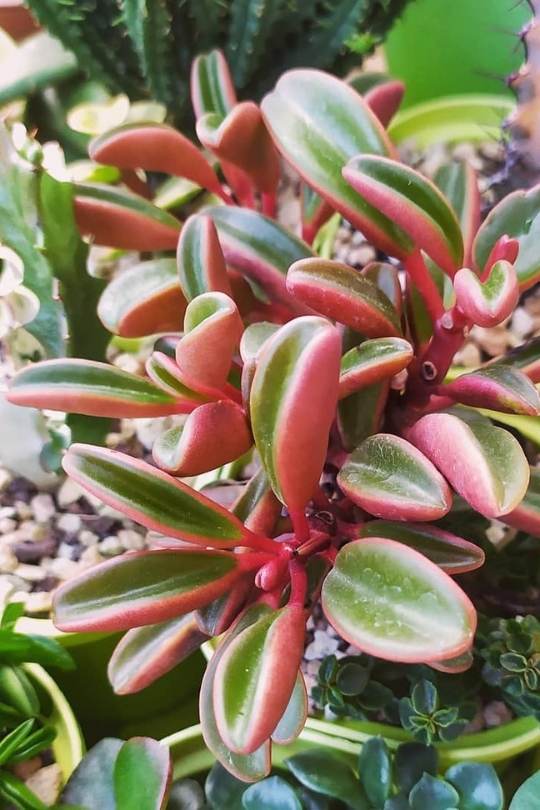
Ruby glow peperomia plants are a succulent-like plant with thick, fleshy leaves and a compact growth form. Their tongue-shaped leaves have a deep crease down the centre, creating a v-shape.
These beautiful leaves are light green, with pink edges and a pinkish-red underside. Native to dry regions of southern Ecuador, these plants are quite easy to care for. They are ideal for low-light environments, as they thrive in partial sun or even shaded areas.
These peperomias require minimal watering and remain very compact, rarely reaching any taller than 25cm.The botanical name graveolens actually means “bad-smelling” in Latin.
If you bring your nose close enough to the plant, you may smell a slightly foul odor.
12. Peperomia angulata or Peperomia quadrangularis (Beetle Peperomia)
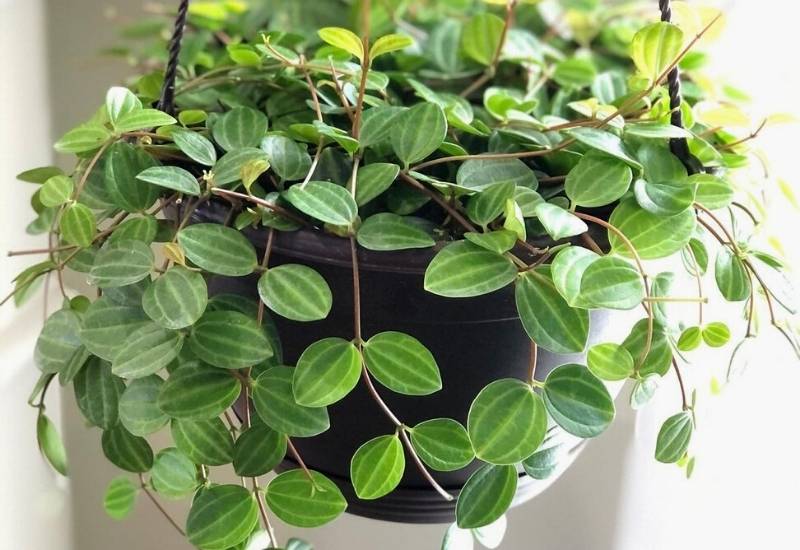
The beetle peperomia is a trailing peperomia plant variety with succulent-like leaves and long trailing stems.
The leaves are dark green with a light green striped pattern and reddish stems, similar to the watermelon peperomia, however the colors are less intense.
These peperomias will do best with moderate, indirect light or partial shade. They have a convenient tolerance to neglect, making them a great choice for beginner plant owners.
With its stringy stems and cascading foliage, this small peperomia is perfect for hanging baskets. The stems can also be trained to climb upwards if given proper support.
13. Peperomia ‘Ruby Cascade’
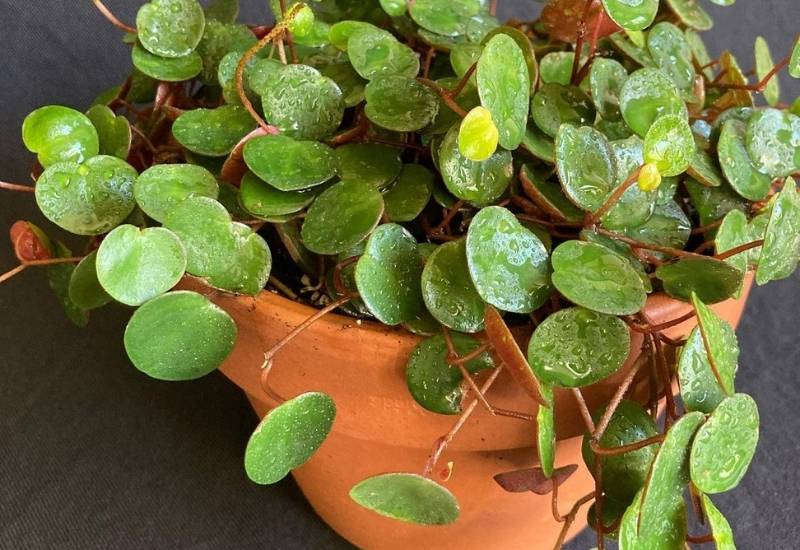
The peperomia ‘ruby cascade’ is a lovely trailing peperomia plant variety with succulent-like leaves. Its round, thick, waxy leaves will appear with a green surface and purple undersides, growing on thin ruby-red stems.
With its growth habit as a trailing plant, they are best suited for growing in hanging baskets.
The succulent-like leaves of the ruby cascade are able to store water, so allowing the soil to dry between watering is important. This plant is highly vulnerable to root rot from overwatering.
14. Peperomia polybotrya (Raindrop peperomia)
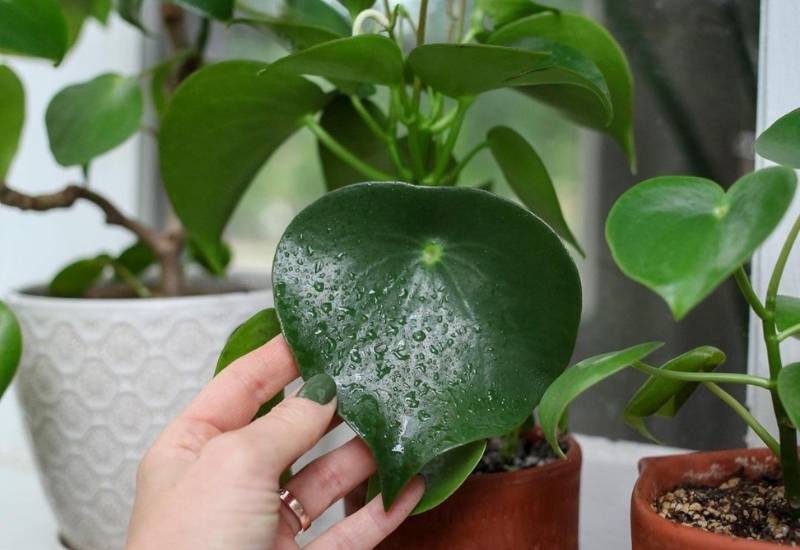
The name ‘raindrop’ peperomia is a perfect fit for the description for the leaves of this plant. The shiny green leaves of this plant appear in the shape of an oval, which tapers to a point like a typi-cal raindrop.
This peperomia can grow pretty big in comparison to other peperomia plants. It grows in an upright form, reaching about 30cm tall and 10cm wide.
The raindrop peperomia variety prefers brighter conditions in order to maintain its lush green foliage.
Unlike most peperomias, it can even handle a small amount of direct sunlight. Other common names include coin-leaf peperomia and coin plant, due to the shape of its leaves.
15. Peperomia puteolata (Parallel Peperomia)
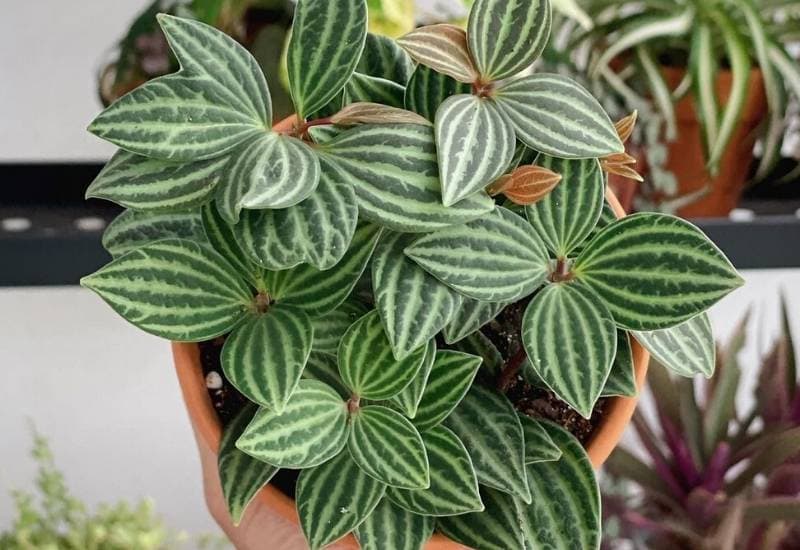
The parallel peperomia gets its name form its long, skinny leaves which appear dark green with silver stripes, or veins. Unlike most other peperomia plants, this plant is relatively fast-growing. With its vibrant foliage, bright indirect light is important.
An easy type of peperomia plant to care for, it is able to tolerate neglect well. This plant can adapt to a variety of different environments as long as it receives adequate, indirect light and does not get overwatered.
When the parallel peperomia is small, this peperomia variety grows in an upright form form.
As the plant matures and grows larger, the thin reddish-brown stems are unable to support the weight of the foliage. This will cause the stems to droop and take on more of a trailing nature.
Conclusion
Peperomia plants make excellent houseplants with their eye-catching, tropical foliage and easy care requirements.
Thorough yet infrequent watering, bright indirect light, and occasional misting for increased humidity are the keys to success with these perennial epiphytes.
Since many of the most common peperomias feature succulent-like leaves, they are able to store extra water and thrive in times of neglect. This is also the reason that these plants are highly sus-ceptible to root rot if overwatered.
Peperomias are an ideal houseplant for the beginner plant owner and experienced horticulturalist alike.
With over 1500 species and a variety of growth forms to choose from, you’re sure to find the right one for you.

Written By
Amber Noyes
Amber Noyes was born and raised in a suburban California town, San Mateo. She holds a master’s degree in horticulture from the University of California as well as a BS in Biology from the University of San Francisco. With experience working on an organic farm, water conservation research, farmers’ markets, and plant nursery, she understands what makes plants thrive and how we can better understand the connection between microclimate and plant health. When she’s not on the land, Amber loves informing people of new ideas/things related to gardening, especially organic gardening, houseplants, and growing plants in a small space.

Very informative material, I’m fascinated with these unusual plants especially the foliage, have a few and plan to get more, thanks Amber for your expertise.
Hi there.. I have a Small baby Teardrop Peperomium.. which when I repotted.. into a bigger pot… few months back.. the 4 leaves Stooped over a bit.. and are still a lovely green.. but they have not grown bigger.. still under 2 inches.. I want to ask you.. what is Fertilizing.. mean.. ! Mist regularly for increased humidity… So buying a misting bottle.. to put water in a plastic bottle. with water.. spreyer ..will make the water come out like a Mist..! Also, can I mix in a small amount of Thrive.. Plant Food.. Also in brackets here ( Well-draining peat-based soil. 2 parts peat and 1 part perlite or sand is ideal.).. are you able to tell m please.. which kinds of potting mixes I need.. as about.. not sure what perlie is.. or 2 parts of Peat.. Mean.. Please an you explain.. I am a plant crazy admirer of your’s.. Love to hear back from you please.. with any advice.. as well. am searching for a Pennywort Begonia.. My cat hit my plant over.. and I was never able to save it.. and I have been looking for Months.. I ‘d love to know where I could find one.. that wouldn’t cost me the Heavens.. My husband lost his job last August.. so it’s only me working… and these Plants.. Cheer me up Alot.. they are my happiness.. I only have around a dozen different house plants.. and I want to help make them Thrive.. !! Many Thank for Your Advice Patricia…
Thanks alot for that information where it’s so informative to me especially the types . Appreciate your knowledge.